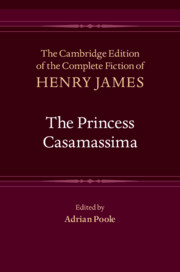Book contents
- Frontmatter
- Contents
- List of Illustrations
- Acknowledgements
- List of Abbreviations
- General Editors’ Preface
- General Chronology of James’s Life and Writings
- Introduction
- Textual Introduction
- Chronology of Composition and Production
- Bibliography
- The Princess Casamassima
- Glossary of Foreign Words and Phrases
- Notes
- Textual Variants I: Substantive Variants up to Copy Text
- Textual Variants II: Substantive Variants after Copy Text
- Emendations
- Appendix: Preface to New York Edition
XXXIII
Published online by Cambridge University Press: 11 April 2021
- Frontmatter
- Contents
- List of Illustrations
- Acknowledgements
- List of Abbreviations
- General Editors’ Preface
- General Chronology of James’s Life and Writings
- Introduction
- Textual Introduction
- Chronology of Composition and Production
- Bibliography
- The Princess Casamassima
- Glossary of Foreign Words and Phrases
- Notes
- Textual Variants I: Substantive Variants up to Copy Text
- Textual Variants II: Substantive Variants after Copy Text
- Emendations
- Appendix: Preface to New York Edition
Summary
The house in Madeira Crescent was a low, stucco-fronted edifice, in a shabby, shallow semicircle, and Hyacinth could see, as they approached it, that the window-place in the parlour (which was on a level with the street-door), was ornamented by a glass case containing stuffed birds and surmounted by an alabaster Cupid. He was sufficiently versed in his London to know that the descent in the scale of the gentility was almost immeasurable for a person who should have moved into that quarter from the neighbourhood of Park Lane. The street was not squalid, and it was strictly residential; but it was mean and meagre and fourth-rate, and had in the highest degree that paltry, parochial air, that absence of style and elevation, which is the stamp of whole districts of London and which Hyacinth had already more than once mentally compared with the high-piled, important look of the Parisian perspective. It possessed in combination every quality which should have made it detestable to the Princess; it was almost as bad as Lomax Place. As they stopped before the narrow, ill-painted door, on which the number of the house was marked with a piece of common porcelain, cut in a fanciful shape, it appeared to Hyacinth that he had felt, in their long walk, the touch of the passion which led his companion to divest herself of her superfluities, but that it would take the romantic out of one's heroism to settle one's self in such a mesquin, Philistine row. However, if the Princess had wished to mortify the flesh she had chosen an effective means of doing so, and of mortifying the spirit as well. The long light of the gray summer evening was still in the air, and Madeira Crescent wore a soiled, dusty expression. A hand-organ droned in front of a neighbouring house, and the cart of the local washerwoman, to which a donkey was harnessed, was drawn up opposite. The local children, as well, were dancing on the pavement, to the music of the organ, and the scene was surveyed, from one of the windows, by a gentleman in a dirty dressing-gown, smoking a pipe, who made Hyacinth think of Mr. Micawber.
- Type
- Chapter
- Information
- The Princess Casamassima , pp. 327 - 335Publisher: Cambridge University PressPrint publication year: 2020

